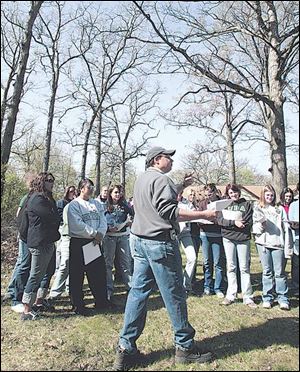
Students mark Arbor Day by planting trees, learning care
4/28/2006
Pat O'Brien, who works for the City of Toledo Division of Forestry, speaks to students from Notre Dame Academy about tree care, invasive species, and habitat improvement.
Until yesterday, Dan Gray had never seen a black locust tree and didn't know that it can't grow flowers until it is 15 years old. He'd never planted one either.
Standing with a shovel in hand, in a green floodplain at the foot of "suicide hill," which is known as the best sledding slope at Ottawa Park, the 17-year-old Woodward High School senior was one of more than 100 students who spent the morning learning about trees and their habitats in observance of Arbor Day.
"You started a tree's life here, and that is the foundation of a forest," Denny Garvin, a naturalist and supervisor of nature education and marinas for the city of Toledo parks told a group of Woodward students during a habitat improvement session.
The students from Woodward, Notre Dame Academy, and Scott High School spent the morning strolling the park's hills learning about tree care and maintenance, invasive species and pathogens, and habitat improvement.
In town today for Arbor Day will be Undersecretary Mark Rey, of the U.S. Department of Agriculture, who will attend an event at the Sisters of St. Francis Motherhouse at the invitation of U.S. Rep. Marcy Kaptur (D., Toledo).
Mr. Rey will present two chestnut trees to the convent, but also intends to discuss federal involvement in the fight against the Emerald Ash Borer beetle, which has killed millions of ash trees in Ohio and Michigan.
During his session yesterday, Mr. Garvin explained the qualities of different trees and shrubs and how they relate to forest inhabitants like songbirds, mammals, and insects. But mostly he stressed the importance of understanding the effects of forest fragmentation - the biggest problem that forests face.
"Any given forest can only hold so much life, and that is a consequence of forest fragmentation," he said, standing on a patch of grass that he described as a landscape bridge between a forest and undeveloped flood land.
"We used to have black bears in this area, and now they are all gone because we don't have enough forest space," Mr. Garvin said, noting that Ottawa Park, the oldest in Toledo, has only recently seen the return of deer, red fox, and birds, "because we connected these two forests, which nurture wildlife."
For Jamie Elmer, 18, a Woodward junior, the session was not only a learning experience but also a chance to get her hands dirty. "This is so much fun. I haven't planted anything since I was a child, but I love being outdoors and walking around parks."
Even Jamison Williams, 18, who doesn't consider himself a nature enthusiast, was impressed by some of the self-correcting mechanisms of forest environments.
Mr. Williams listened intently as Mr. Garvin explained the importance of poison ivy in forest habitats and how dandelions arrived in the United States. "Essentially, if you don't mow your lawn, you get a forest," Mr. Garvin said.
"I like that," Mr. Williams, a Woodward senior said as he walked to the field where his class planted plum and birch trees yesterday. "I like how they have connected these two forests to create a habitat for all kinds of wild inhabitants," he said.
That appreciation for forests and nature, Mr. Garvin said, is the reason why educational observances of Arbor Day are important. "All these students planted a tree here today," he said. "Every time they come here again, they will remember that."
Contact Karamagi Rujumba at:
krujumba@theblade.com
or 419-724-6064.